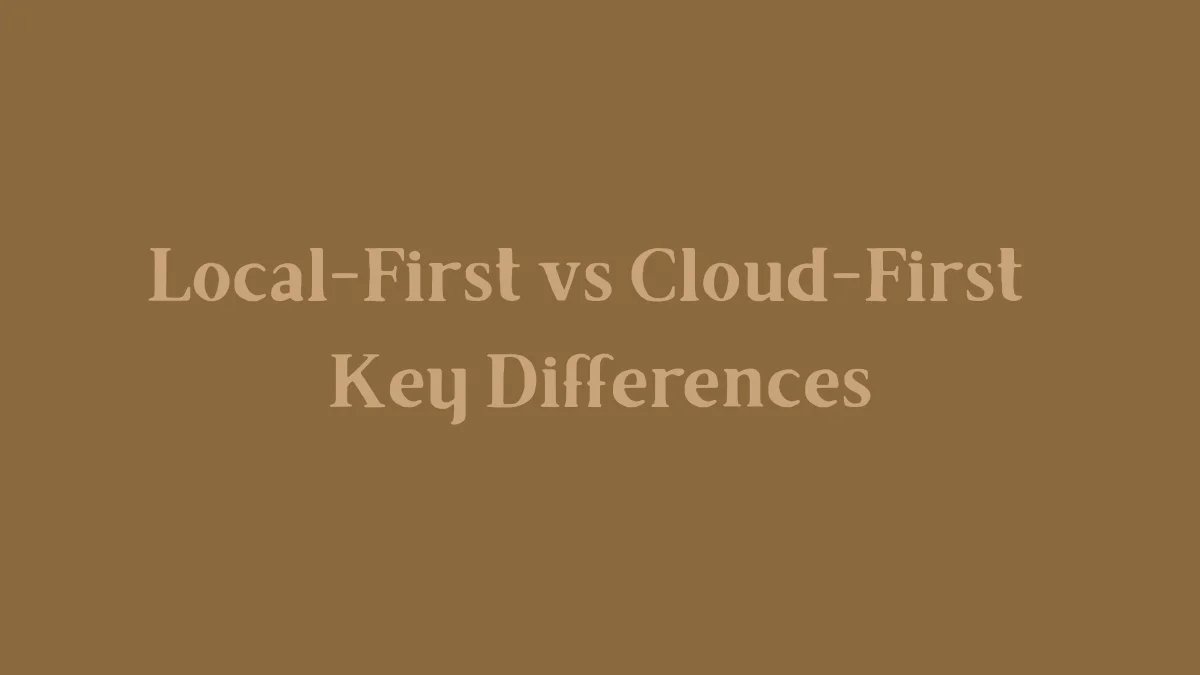The software industry has spent the last decade shifting toward cloud-first design. Everything moved online: documents, tasks, calendars, finances, writing, even basic tools that used to run entirely on local devices. At first, this created real convenience because you can get access anywhere, automatic syncing, backups, and collaboration.
But over time, the cloud-first model created new problems: rising subscription fees, dependency on internet access, platform lock-in, unpredictable outages, and a lack of user control.
This is where local-first comes in. It isn’t a rejection of the cloud. Local-first puts the user and not the platform back at the centre of the software experience.
Cloud-First in Plain Terms
Cloud-first design means:
- your data lives primarily on a remote server
- the tool requires an internet connection
- the company controls the system
- your access depends on their uptime
- your data belongs to the platform unless exported
- you often pay monthly to keep using it
Cloud-first made sense when devices were slow and syncing was difficult. Today, devices are powerful, storage is cheap, and offline capability matters again.
What Local-First Really Means
Local-first prioritises:
- your device
- your data
- your privacy
- optional cloud sync
Instead of storing everything in the cloud and then syncing it to your device, local-first tools:
- store data on your device first
- work offline
- offer peer-to-peer or optional cloud sync
- give you full ownership
- ensure you can continue using the tool, even if external services disappear
This is not a “back to old-fashioned computing” idea. It’s a modern approach that returns power back to the user.
Key Philosophical Difference
Cloud-first: “Your data lives with us by default.”
Local-first: “Your data lives with you by default.”
Why People Are Turning Back to Local-First
The shift toward local-first is happening because people are:
- fatigued by subscriptions
- frustrated by platform changes
- worried about privacy
- wanting tools that last
- tired of losing data when a platform shuts down
- wanting tools that work offline and online
- wanting independence
Creators and small business owners are especially affected by SaaS unpredictability.
Local-first provides something increasingly rare: autonomy.
Cloud-First vs Local-First: Practical Differences
1. Where Your Data Lives
Cloud-First: Stored remotely, usually encrypted—but not always under your ownership.
Local-First: Stored on your device. You choose if and where it syncs.
2. Who Controls Access
Cloud-First: If a service goes down, your data becomes inaccessible.
Local-First: You retain access regardless of external outages.
3. Privacy
Cloud-First: Data passes through multiple systems outside your control.
Local-First: Your data never leaves your device unless you decide to sync it.
4. Cost
Cloud-First: Recurring subscription fees.
Local-First: Often free or one-time purchase.
5. Longevity
Cloud-First: Available long-term but if the platform closes, your workflow breaks.
Local-First: The tool continues to work indefinitely. Although over the years it does age.
6. Customisation
Cloud-First: Limited or none.
Local-First: Often fully customisable—especially for open-source or self-hosted tools.
Where Local-First Works Best
Local-first shines in categories where:
- privacy is a priority
- long-term stability matters
- internet access isn’t guaranteed
- the work is personal or creative
- the user wants independence
Examples:
- journaling
- personal planning
- financial organising
- habit and goal tracking
- writing
- personal knowledge management
- small business admin
- offline-first productivity
Where Cloud-First Still Makes Sense
Some things still benefit from the cloud:
- large-scale collaboration
- real-time multi-user editing
- enterprise admin tools
- global access for distributed teams
Local-first isn't “better”—it’s “better for certain types of work.”
Frequently Asked Questions About Local-First
1. Is local-first just old-fashioned software?
Local-first isn’t a return to outdated software. It’s a modern approach that uses today’s device power and storage to create faster, more responsive, more private applications. Unlike old offline tools, local-first supports optional sync, sharing, and connectivity without forcing everything through a single cloud service. It combines the best of both eras—modern functionality with personal ownership. Many of today’s most respected developer communities view local-first as the future, not the past.
2. Does local-first work without the internet?
Yes. This is one of its key advantages. Local-first means the tool functions fully on your device even when you’re offline or travelling. You can write, plan, track habits, or organise your data without needing constant connectivity. If you choose to sync, it will happen when you are back online, using a method you control. This makes local-first tools more reliable, especially for creators and solo workers who don’t always have consistent internet access.
3. What happens to cloud features?
Local-first doesn’t remove cloud features, it simply makes them optional. You can still sync across devices, back up your data, send files to the cloud, or collaborate when necessary. The difference is that these features are chosen by the user, not demanded by the platform. Some tools use peer-to-peer sync, others use encrypted folders, and some integrate optional cloud services. The flexibility ensures you can use cloud when needed without relying on it for everything.
4. Is local-first secure?
Local-first tools are often more secure because your data isn’t exposed to large cloud systems or multi-tenant environments. The attack surface is smaller, and you control the device where your data lives. While cloud providers do offer strong security, they also create risks through centralisation. Local-first tools reduce this exposure. As long as your device is secure and updated, local-first tools can provide excellent privacy and protection against external threats.
5. Why is cloud-first becoming a problem for people?
Cloud-first platforms increasingly limit flexibility: they change pricing, restrict features, collect more data, and sometimes remove functionality entirely. People feel locked in and dependent on tools they don’t control. When a service changes direction, or shuts down, users lose access or face costly migrations. For creators, freelancers, and small business owners who rely heavily on stable tools, this instability becomes unsustainable. Local-first reduces these pressures and restores long-term dependability.
6. Can a tool be both local-first and cloud-first?
Yes, but only to an extent. A hybrid model is possible where a tool is local-first at its core but integrates cloud sync or cloud-based collaboration features. This approach gives users the benefits of independence while retaining optional conveniences of cloud access. Many modern apps are starting to move in this direction, giving people more choices without forcing them into strict cloud dependency. It’s often the most flexible architecture.
Other Articles Worth Reading
Thanks for sharing:



